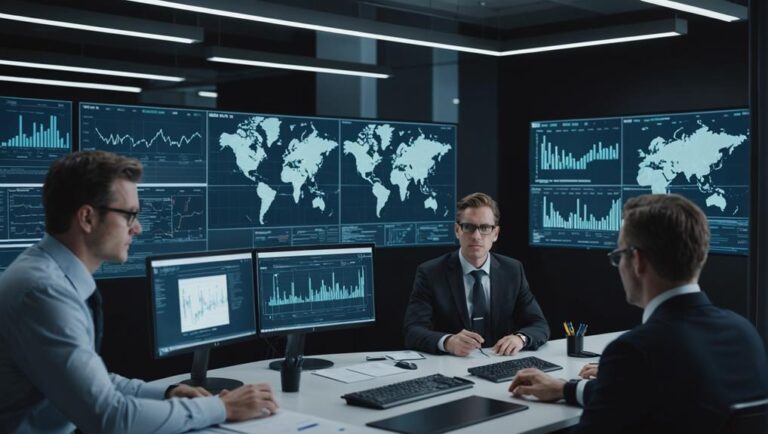Vendor and Third-Party Technology Assessment in M&A Due Diligence

In M&A due diligence, it is crucial to thoroughly evaluate vendor and third-party technology to uncover both risks and opportunities, ultimately ensuring a successful acquisition. One must meticulously review the reliability, financial stability, and service levels of vendors to gauge their potential impact on the deal.
Additionally, conducting comprehensive security and compliance checks is essential to assess cyber risks and ensure adherence to regulatory standards. Identifying integration challenges, such as system alignment and data privacy considerations, can help prevent operational disruptions post-acquisition.
Mitigating technological risks necessitates a detailed examination of legacy systems and potential vulnerabilities that could affect the overall success of the merger or acquisition. By closely examining these areas, organizations can enhance their ability to secure and maximize their investment in the target company.
Taking a proactive approach to assessing vendor and third-party technology can significantly contribute to the overall success of the M&A deal.
In summary, a meticulous evaluation of vendor and third-party technology is essential in M&A due diligence to mitigate risks and maximize the potential benefits of the acquisition. By carefully examining factors such as vendor reliability, security measures, and integration challenges, organizations can make informed decisions that drive the success of the deal.
Key Takeaways
- Evaluate the vendor's financial stability thoroughly to ensure their long-term viability and robust support capabilities.
- Perform in-depth security risk assessments to pinpoint potential cyber threats and vulnerabilities that could jeopardize the technology assets.
- Scrutinize the service level agreements to verify their alignment with the M&A objectives and performance expectations set forth.
- Review the vendor's compliance with regulatory standards to guarantee adherence to legal requirements and mitigate any potential risks associated with non-compliance.
- Analyze the integration challenges carefully to ensure a smooth alignment of technology systems and processes during the M&A transition.
Importance of Technology Assessment
Evaluating a target company's technological assets is crucial during M&A due diligence to uncover risks, potentials, and ensure a successful acquisition. When delving into the technology assets of a target company, we're not just going through a checklist; we're uncovering the essence of what drives the business. This assessment enables us to identify potential risks and vulnerabilities that could impede the transaction. Understanding the security posture allows us to assess the company's resilience against cyber threats, a pivotal aspect in today's digital environment.
In M&A deals, conducting due diligence on technology assets empowers us to craft effective negotiation strategies. Understanding the target company's IT infrastructure and level of innovation can significantly influence the deal structure and purchase price. Furthermore, this evaluation highlights growth opportunities that can be utilized for a competitive edge. It's not only about the current state of the company but also about its potential with the right technological investments.
After the acquisition, comprehending these tech assets aids in risk mitigation, ensuring a seamless transition and safeguarding the acquired company's value. The focus is on laying the groundwork for smooth integration and future-proofing our investment.
Evaluating Vendor Reliability
Ensuring vendor reliability is crucial to guarantee they can consistently deliver high-quality technology solutions that align with our M&A objectives. Our initial step involves evaluating the vendor's track record, focusing on their history of completing projects on time and within budget. This assessment provides a clear indication of their operational efficiency and dependability.
Client testimonials and references play a significant role in providing insights into the vendor's reputation. Positive feedback from past clients can signal a strong level of customer satisfaction and excellence in service delivery. Additionally, examining the vendor's financial stability is essential to verify their long-term viability in supporting our needs.
Thorough scrutiny of service level agreements is imperative to understand the terms and obligations involved. These agreements underscore the vendor's dedication to service quality and assist in identifying any potential risks that may arise.
Conducting technical assessments is a critical aspect of our evaluation process. We analyze the vendor's technology stack, security measures, and scalability to ensure they're in line with our M&A objectives. This evaluation allows us to assess their capability to address both our current requirements and future growth.
A comprehensive assessment of vendor reliability is essential in selecting partners who not only meet our present needs but also have the capacity to evolve alongside us in the future.
Security and Compliance Checks
After assessing the vendor's reliability, our focus shifts to their security and compliance measures to ensure robust protection and adherence to regulatory standards. Thorough security and compliance checks are vital in our M&A transactions. We examine cybersecurity measures, data protection protocols, and regulatory compliance to pinpoint potential vulnerabilities and gaps in security controls.
During our due diligence process, we conduct detailed security risk assessments to gauge the cyber risk associated with the target company's technology infrastructure. We analyze their capacity to protect sensitive data, as any vulnerabilities in this area could significantly heighten our risk exposure.
Equally significant is compliance adherence. We scrutinize certifications, policies, and procedures to verify alignment with industry standards and legal requirements. This confirms the vendor's dedication to upholding regulatory compliance and managing third-party risk effectively.
Vendor onboarding remains incomplete without these rigorous checks. We evaluate the efficacy of security controls, incident response capabilities, and overall protection of digital assets. This ensures that the technology infrastructure we integrate into our operations is secure, compliant, and equipped to fend off cyber threats. This systematic approach bolsters our third-party risk management and safeguards our investment.
Identifying Integration Challenges
One major hurdle in M&A due diligence is aligning the technology systems and processes of both companies. Identifying compatibility issues between the acquiring and target company's technology infrastructure is crucial for ensuring a seamless technology integration. This requires a comprehensive evaluation of vendors and third-party analysis to assess potential disruptions.
There are four key areas to focus on:
- Cybersecurity Risks: Assessing and addressing cybersecurity risks is essential. It's imperative to ensure that the security protocols of both companies are compatible and robust enough to manage potential threats during the M&A process.
- Data Privacy Concerns: Protecting data privacy is of utmost importance. Evaluating how each company handles data and ensuring adherence to relevant regulations can help minimize risks during the integration phase.
- Stakeholder Communication: Effective communication with stakeholders is vital for overcoming integration challenges. Providing clear and consistent updates, as well as fostering collaboration, can help manage expectations and reduce resistance to change.
- Change Management: Implementing a detailed change management strategy is critical. This helps employees transition smoothly to new systems and processes, reducing the likelihood of operational disruptions.
Mitigating Technological Risks
Mitigating technological risks in M&A involves carefully assessing the target company's technology assets, cybersecurity measures, and regulatory compliance. Through thorough due diligence, we can uncover any legacy systems, cybersecurity vulnerabilities, and technical debt that may pose a threat to a successful merger. Third-party due diligence is particularly crucial to identify potential security assessment gaps and data integrity issues.
Evaluating the target's technology assets allows us to pinpoint integration challenges and ensure compatibility with our current infrastructure. This assessment is vital for effective risk mitigation, enabling us to address intellectual property risks and enhance inadequate disaster recovery plans. By taking a proactive approach, we can minimize disruptions post-acquisition and maximize operational synergies.
Furthermore, understanding the target company's scalability and adherence to regulatory standards is essential to reduce legal and operational obstacles. A comprehensive security assessment will highlight any weaknesses in their cybersecurity measures, empowering us to strengthen defenses post-acquisition. By focusing on these key areas, we can improve operational efficiency, reduce expenses, and facilitate a smoother integration process.
Ultimately, thorough technological due diligence and risk mitigation strategies not only safeguard our investment but also position us to capitalize on innovative solutions, fostering long-term success in our M&A endeavors.
Frequently Asked Questions
What Is Third Party Vendor Due Diligence?
We conduct thorough due diligence on third-party vendors to assess risks, ensure regulatory compliance, and address cybersecurity concerns. Our evaluation includes analyzing the target company's financial stability, contractual terms, service performance, operational efficiency, data protection measures, key performance indicators, and contingency plans. This comprehensive approach helps us make informed decisions and drive innovation in the realm of mergers and acquisitions.
In the context of mergers and acquisitions, technology due diligence plays a crucial role in assessing the potential impact of integrating a new technology provider. By conducting a deep dive into the technology infrastructure, software systems, and cybersecurity protocols of the target company, we can identify any potential vulnerabilities, compatibility issues, or opportunities for optimization. This proactive approach helps us mitigate risks, enhance operational efficiency, and ensure a seamless integration process.
In today's fast-paced business environment, staying ahead of the curve in terms of technology is essential for sustainable growth and competitive advantage. By leveraging data-driven insights and strategic analysis in our M&A technology due diligence process, we can unlock hidden value, identify synergies, and drive strategic decision-making. This proactive and holistic approach enables us to navigate the complexities of the M&A landscape with confidence and drive long-term success.
What Is the Third Party Vendor Assessment Process?
Studies show that 60% of businesses fall victim to data breaches caused by their vendors. Our comprehensive assessment process delves into vendors' risk management practices, compliance with regulations, cybersecurity vulnerabilities, financial robustness, and service reliability. By ensuring data security, operational effectiveness, and adherence to legal and contractual obligations, we mitigate the risks associated with third-party partnerships.
What Is the Due Diligence Questionnaire for Third Parties?
We approach the due diligence questionnaire by centering on risk management, compliance checks, and financial stability. Our evaluation encompasses data security, contract terms, service levels, reputation analysis, performance metrics, legal obligations, and cyber threats to ensure successful and strategic partnerships in mergers and acquisitions (M&A).
M&A technology due diligence is crucial in assessing the compatibility and potential risks associated with integrating new technologies and systems. By conducting thorough due diligence, companies can mitigate potential challenges, ensure regulatory compliance, and enhance operational efficiency in the post-merger integration phase.
Effective due diligence in M&A transactions involves analyzing the target company's technology infrastructure, intellectual property rights, cybersecurity protocols, and IT governance practices. By leveraging advanced analytics and industry benchmarks, organizations can make informed decisions and capitalize on the technological capabilities of the target company to drive growth and innovation.
In today's digital age, the success of M&A deals often hinges on the seamless integration of technology systems and processes. By prioritizing technology due diligence and adopting a proactive approach to risk management, companies can maximize the value of their M&A transactions and position themselves for long-term success in the competitive marketplace.
What Is the Difference Between Due Diligence and Vendor Due Diligence?
Imagine due diligence as a broad shield encompassing risk reduction, financial examinations, and regulatory verifications during mergers and acquisitions. Vendor due diligence, on the other hand, acts as a precise laser beam, honing in on data security, vendor dependability, and performance benchmarks. Both processes ensure seamless service continuation and adherence to legal requirements.
In the realm of M&A technology due diligence, due diligence serves as a critical tool for assessing the risks and opportunities associated with integrating new technologies into existing business operations. It involves a thorough examination of the technology infrastructure, intellectual property rights, cybersecurity measures, and compliance frameworks of the target company. This comprehensive evaluation helps the acquiring company make informed decisions and mitigate potential risks before finalizing the deal.
Vendor due diligence, specifically in the context of M&A technology transactions, focuses on evaluating the technology vendors or service providers that are essential to the target company's operations. It involves scrutinizing the vendor's capabilities, reliability, and track record in delivering technology solutions. By conducting vendor due diligence, the acquiring company can assess the vendor's ability to support the technology needs of the target company post-acquisition and ensure a smooth transition of services.
Conclusion
In our M&A due diligence process, we've observed that assessing vendor and third-party technology plays a crucial role.
Evaluating vendor reliability, conducting thorough security and compliance checks, and pinpointing potential integration challenges are key steps to mitigating technological risks effectively.
This proactive approach ensures a seamless transition and safeguards our investment. Ultimately, a comprehensive technology assessment isn't just about risk reduction; it's also about confirming that the technological infrastructure aligns with our strategic objectives, guaranteeing long-term success and stability.





